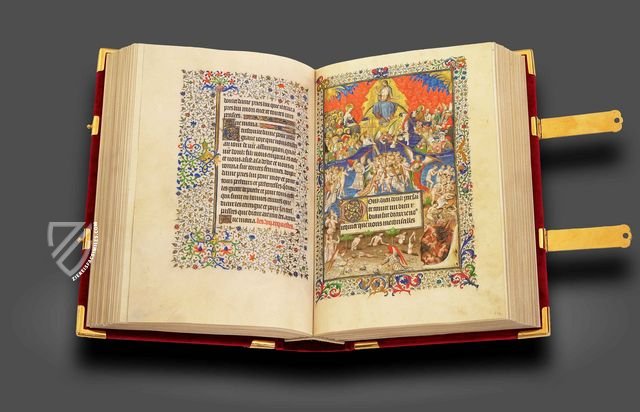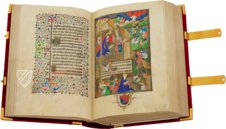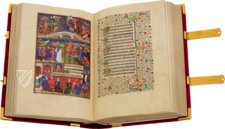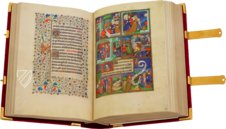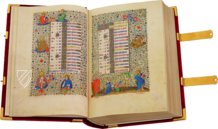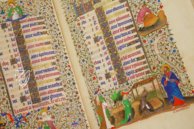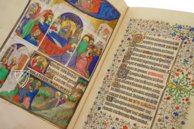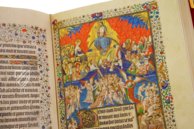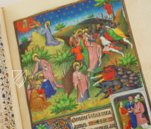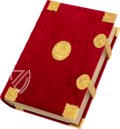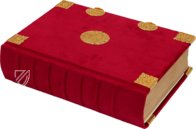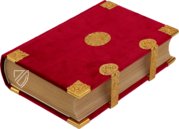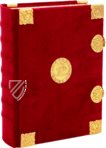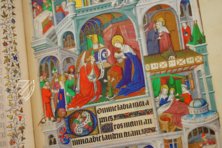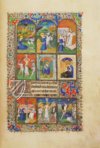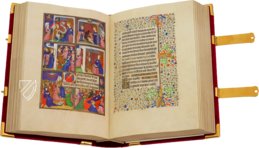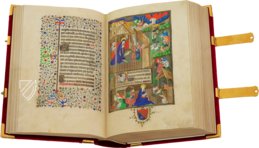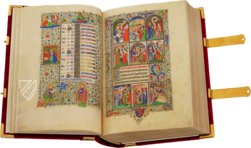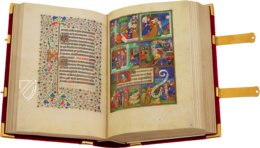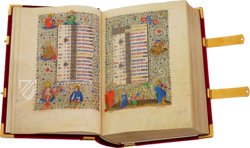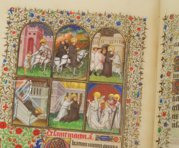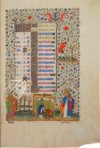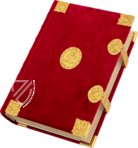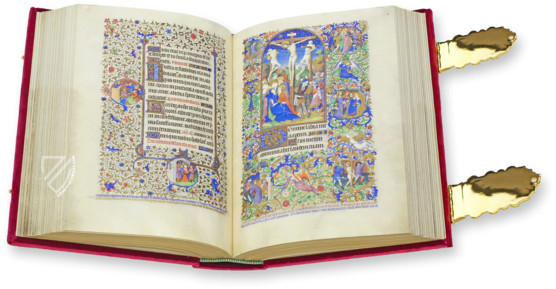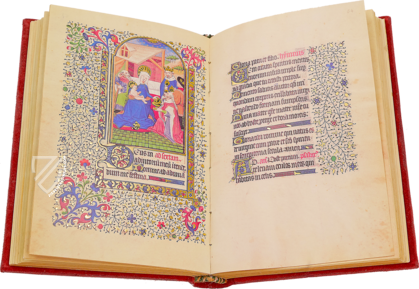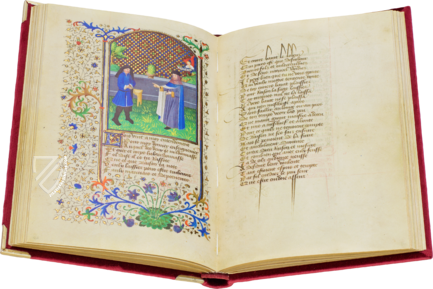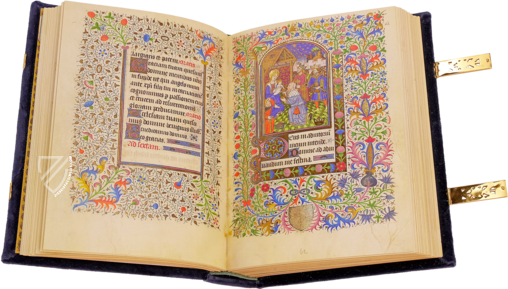Sobieski Hours
The breathtaking Sobieski Hours is one of the greatest masterpieces of French Gothic book illumination. It was commissioned by Margaret of Burgundy (1393–1441) around 1420 and was probably intended as a precious wedding gift for her marriage to Arthur III (1393–1458), Duke of Brittany. This pinnacle of Parisian book illumination comprises 468 pages with 60 full-page miniatures, more than 400 elaborate marginal illuminations, and 60 large-format and countless smaller decorated initials, which accompany and complement the pious prayers for private devotion. Since such an extensive illumination would have been almost impossible for a single artist to accomplish, the Bedford Master was joined by the Fastolf Master and the Master of the Munich Legenda Aurea who made a decisive contribution to the work. These three leading miniaturists of the time probably spent several years working on the harmonious images with their remarkable panoramas of enchanting landscapes and inventive architecture.
Sobieski Hours
A highpoint of late Gothic illumination was supposedly commissioned by Margaret of Burgundy (1393–1441) ca. 1420: the Sobieski Hours. It is believed to have been a wedding present for her union with Arthur III (1393–1458), the Duke of Brittany. The 468-page parchment manuscript contains prayers in French and Latin for private devotion, which are complimented by an unbelievable 60 full-page miniatures, 400+ illustrated scenes, as well as 66 large-format and countless smaller historiated initials. This imposing mass of illumination could not have been tackled by a single artist, and actually, the three leading masters of their time participated in the lavish design over an extended period.
Many Helping Hands
A large number of miniatures are attributed to the famous Bedford Master, who was active in Paris between 1405 and 1465. Since it is unlikely that he could have painted all the depictions, he probably gave compositions to his assistants or presented them with models. Furthermore, the Fastolf Master and the Master of the Munich Legenda Aurea also made equally important contributions to the decoration. The former worked in Paris and Normandy, just like the second, whose activity in Paris between 1430 and 1440 can be proven. Although he was a disciple of the Bedford Master, he developed his own conspicuous style. Nonetheless, although the stylistic details of the respective masters is discernable, the artistry is surprisingly uniform and harmonious, it is characterized by carefully modeled human figures and draperies.
A Medieval Picture Story
It is astonishing with what attention to detail and artistic virtuosity the splendid miniatures were painted. Two styles of composition are present. In the earlier sections, especially those dealing with the Hours of the Virgin, the scenes have a more holistic perspective and are depicted panoramically with sweeping landscapes, fantastical architectures, and three-dimensional interior spaces. Later sections are distinctly more intimate, divided into six or nine individual scenes with golden frames. Precious gold and silver leaf and high quality paints like lapis lazuli were used throughout by all of the artists involved. All of the miniatures and marginalia display an artistic mastery that makes the codex a milestone of art history.
A Turbulent History
Despite the incredible artistry of the manuscript, or perhaps because of it, this codex has a turbulent ownership history about which little is known. The great artistry and the masters involved with its creation point to a high-ranking patron nonetheless. Although it has since fallen out of favor as a theory, it was originally thought to have been a wedding present for Margaret of Burgundy (1393–1442), sister of Duke Philip the Good (1396–1467), upon her union with Duke Arthur III of Brittany (1393–1458). It is known, however, that the codex came into the possession of King John III Sobieski of Poland (1629–96), hero of the Battle of Vienna (1683), sometime in the 17th century. It passed to the British royal family through the marriage of his granddaughter Maria Clementina Sobieska to James Francis Edward Stuart (1688–1766), the son of the deposed King James II, called the “Old Pretender”, who then bequeathed it in 1803 to the future King George IV (1762–1830). Today, it is counted as one of the most coveted treasures of the Royal Library.
Codicology
- Alternative Titles
- Sobieski-Stundenbuch
Heures Sobieski - Size / Format
- 468 pages / 28.6 × 19.7 cm
- Origin
- France
- Date
- Ca. 1420
- Epochs
- Style
- Genre
- Script
- Gothic
- Illustrations
- 60 full-page miniautres, 400+ marginal illuminations, and 66 historiated as well as countless smaller decorated initials
- Content
- Book of hours also featuring saint's legends
- Patron
- Probably Margaret of Burgundy
- Artist / School
- Bedford Master
Fastolf Master
Master of the Munich Golden Legend - Previous Owners
- John III Sobieski, King of Poland
James Francis Edward Stuart
King George IV (King of England)
Henry Benedict Stuart
Sobieski Hours
Crucifixion
On the mountain of Golgotha, Christ is shown being prepared for his Crucifixion. Roman legionaries are stripping his clothes from him, exposing his body which is scarred from being flagellated. Dismas and Gestas, the two thieves crucified alongside Jesus, await their fate in white shirts with their hands tied behind their backs. A man stands lazily with a ladder as nails are driven into the hands and feet of the Redeemer and another digs a hole wherein the cross will be erected.

Das Sobieski-Stundenbuch
February: Chopping Wood
Artful calendar pages were a common feature of illuminated books of hours in the Late Middle Ages. Aside from their practical use, they are also decorated with so-called “labors of the month” that offer a glimpse of everyday life during that time of year. The text, figures, and filigree tendril border were all created with the finest paints and gold leaf.
February was a time of great boredom for medieval peasants as there was not much to do aside from tend the animals and keep warm. As such, we see one man chopping down a tree and another warming his feet by the fire in what is probably a woodshed. He is flanked by David and the Gemini symbol on the left and St. Andrew the Apostle on the right, pictured with the X-shaped cross that is named after him.
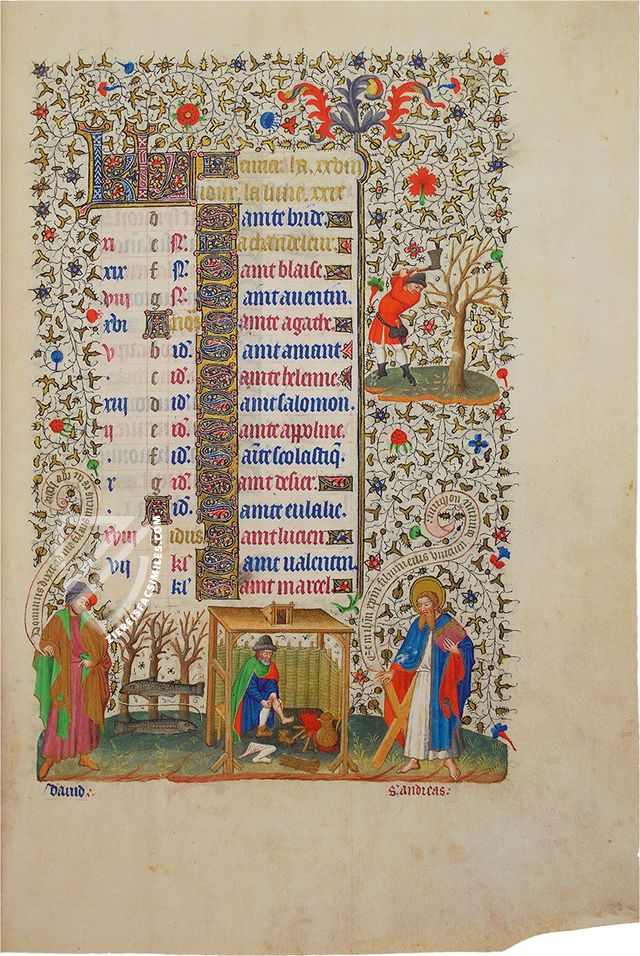
#1 Das Sobieski-Stundenbuch
Languages: English, French, German
- Treatises / Secular Books
- Apocalypses / Beatus
- Astronomy / Astrology
- Bestiaries
- Bibles / Gospels
- Chronicles / History / Law
- Geography / Maps
- Saints' Lives
- Islam / Oriental
- Judaism / Hebrew
- Single Leaf Collections
- Leonardo da Vinci
- Literature / Poetry
- Liturgical Manuscripts
- Medicine / Botany / Alchemy
- Music
- Mythology / Prophecies
- Psalters
- Other Religious Books
- Games / Hunting
- Private Devotion Books
- Other Genres
- Afghanistan
- Armenia
- Austria
- Belgium
- Belize
- Bosnia and Herzegovina
- China
- Colombia
- Costa Rica
- Croatia
- Cyprus
- Czech Republic
- Denmark
- Egypt
- El Salvador
- Ethiopia
- France
- Germany
- Greece
- Guatemala
- Honduras
- Hungary
- India
- Iran
- Iraq
- Israel
- Italy
- Japan
- Jordan
- Kazakhstan
- Kyrgyzstan
- Lebanon
- Liechtenstein
- Luxembourg
- Mexico
- Morocco
- Netherlands
- Palestine
- Panama
- Peru
- Poland
- Portugal
- Romania
- Russia
- Serbia
- Spain
- Sri Lanka
- Sweden
- Switzerland
- Syria
- Tajikistan
- Turkey
- Turkmenistan
- Ukraine
- United Kingdom
- United States
- Uzbekistan
- Vatican City
- A. Oosthoek, van Holkema & Warendorf
- Aboca Museum
- Ajuntament de Valencia
- Akademie Verlag
- Akademische Druck- u. Verlagsanstalt (ADEVA)
- Aldo Ausilio Editore - Bottega d’Erasmo
- Alecto Historical Editions
- Alkuin Verlag
- Almqvist & Wiksell
- Amilcare Pizzi
- Andreas & Andreas Verlagsbuchhandlung
- Archa 90
- Archiv Verlag
- Archivi Edizioni
- Arnold Verlag
- ARS
- Ars Magna
- ArtCodex
- AyN Ediciones
- Azimuth Editions
- Badenia Verlag
- Bärenreiter-Verlag
- Belser Verlag
- Belser Verlag / WK Wertkontor
- Benziger Verlag
- Bernardinum Wydawnictwo
- BiblioGemma
- Biblioteca Apostolica Vaticana (Vaticanstadt, Vaticanstadt)
- Bibliotheca Palatina Faksimile Verlag
- Bibliotheca Rara
- Boydell & Brewer
- Bramante Edizioni
- Bredius Genootschap
- Brepols Publishers
- British Library
- C. Weckesser
- Caixa Catalunya
- Canesi
- CAPSA, Ars Scriptoria
- Caratzas Brothers, Publishers
- Carus Verlag
- Casamassima Libri
- Centrum Cartographie Verlag GmbH
- Chavane Verlag
- Christian Brandstätter Verlag
- Circulo Cientifico
- Club Bibliófilo Versol
- Club du Livre
- CM Editores
- Collegium Graphicum
- Collezione Apocrifa Da Vinci
- Comissão Nacional para as Comemorações dos Descobrimentos Portugueses
- Coron Verlag
- Corvina
- CTHS
- D. S. Brewer
- Damon
- De Agostini/UTET
- De Nederlandsche Boekhandel
- De Schutter
- Deuschle & Stemmle
- Deutscher Verlag für Kunstwissenschaft
- DIAMM
- Droz
- E. Schreiber Graphische Kunstanstalten
- Ediciones Boreal
- Ediciones Grial
- Ediclube
- Edições Inapa
- Edilan
- Editalia
- Edition Deuschle
- Edition Georg Popp
- Edition Leipzig
- Edition Libri Illustri
- Editiones Reales Sitios S. L.
- Éditions de l'Oiseau Lyre
- Editions Medicina Rara
- Editorial Casariego
- Editorial Mintzoa
- Editrice Antenore
- Editrice Velar
- Edizioni Edison
- Egeria, S.L.
- Eikon Editores
- Electa
- Emery Walker Limited
- Enciclopèdia Catalana
- Eos-Verlag
- Ephesus Publishing
- Ernst Battenberg
- Eugrammia Press
- Extraordinary Editions
- Fackelverlag
- Facsimila Art & Edition
- Facsimile Editions Ltd.
- Facsimilia Art & Edition Ebert KG
- Faksimile Verlag
- Feuermann Verlag
- Folger Shakespeare Library
- Franco Cosimo Panini Editore
- Friedrich Wittig Verlag
- Fundación Hullera Vasco-Leonesa
- G. Braziller
- Gabriele Mazzotta Editore
- Gebr. Mann Verlag
- Gesellschaft für graphische Industrie
- Getty Research Institute
- Giovanni Domenico de Rossi
- Giunti Editore
- Graffiti
- Grafica European Center of Fine Arts
- Guido Pressler
- Guillermo Blazquez
- Gustav Kiepenheuer
- H. N. Abrams
- Harrassowitz
- Harvard University Press
- Helikon
- Hendrickson Publishers
- Henning Oppermann
- Herder Verlag
- Hes & De Graaf Publishers
- Hoepli
- Holbein-Verlag
- Houghton Library
- Hugo Schmidt Verlag
- Idion Verlag
- Il Bulino, edizioni d'arte
- ILte
- Imago
- Insel Verlag
- Insel-Verlag Anton Kippenberger
- Instituto de Estudios Altoaragoneses
- Instituto Nacional de Antropología e Historia
- Istituto dell'Enciclopedia Italiana - Treccani
- Istituto Ellenico di Studi Bizantini e Postbizantini
- Istituto Geografico De Agostini
- Istituto Poligrafico e Zecca dello Stato
- Italarte Art Establishments
- Jan Thorbecke Verlag
- Johnson Reprint Corporation
- Josef Stocker
- Josef Stocker-Schmid
- Jugoslavija
- Karl W. Hiersemann
- Kasper Straube
- Kaydeda Ediciones
- Kindler Verlag / Coron Verlag
- Kodansha International Ltd.
- Konrad Kölbl Verlag
- Kurt Wolff Verlag
- La Liberia dello Stato
- La Linea Editrice
- La Meta Editore
- Lambert Schneider
- Landeskreditbank Baden-Württemberg
- Leo S. Olschki
- Les Incunables
- Liber Artis
- Library of Congress
- Libreria Musicale Italiana
- Lichtdruck
- Lito Immagine Editore
- Lumen Artis
- Lund Humphries
- M. Moleiro Editor
- Maison des Sciences de l'homme et de la société de Poitiers
- Manuscriptum
- Martinus Nijhoff
- Maruzen-Yushodo Co. Ltd.
- MASA
- Massada Publishers
- McGraw-Hill
- Metropolitan Museum of Art
- Militos
- Millennium Liber
- Müller & Schindler
- Nahar - Stavit
- Nahar and Steimatzky
- National Library of Wales
- Neri Pozza
- Nova Charta
- Oceanum Verlag
- Odeon
- Orbis Mediaevalis
- Orbis Pictus
- Österreichische Staatsdruckerei
- Oxford University Press
- Pageant Books
- Parzellers Buchverlag
- Patrimonio Ediciones
- Pattloch Verlag
- PIAF
- Pieper Verlag
- Plon-Nourrit et cie
- Poligrafiche Bolis
- Presses Universitaires de Strasbourg
- Prestel Verlag
- Princeton University Press
- Prisma Verlag
- Priuli & Verlucca, editori
- Pro Sport Verlag
- Propyläen Verlag
- Pytheas Books
- Quaternio Verlag Luzern
- Reales Sitios
- Recht-Verlag
- Reichert Verlag
- Reichsdruckerei
- Reprint Verlag
- Riehn & Reusch
- Roberto Vattori Editore
- Rosenkilde and Bagger
- Roxburghe Club
- Salerno Editrice
- Saltellus Press
- Sandoz
- Sarajevo Svjetlost
- Schöck ArtPrint Kft.
- Schulsinger Brothers
- Scolar Press
- Scrinium
- Scripta Maneant
- Scriptorium
- Shazar
- Siloé, arte y bibliofilia
- SISMEL - Edizioni del Galluzzo
- Sociedad Mexicana de Antropología
- Société des Bibliophiles & Iconophiles de Belgique
- Soncin Publishing
- Sorli Ediciones
- Stainer and Bell
- Studer
- Styria Verlag
- Sumptibus Pragopress
- Szegedi Tudomànyegyetem
- Taberna Libraria
- Tarshish Books
- Taschen
- Tempus Libri
- Testimonio Compañía Editorial
- Thames and Hudson
- The Clear Vue Publishing Partnership Limited
- The Facsimile Codex
- The Folio Society
- The Marquess of Normanby
- The Richard III and Yorkist History Trust
- Tip.Le.Co
- TouchArt
- TREC Publishing House
- TRI Publishing Co.
- Trident Editore
- Tuliba Collection
- Typis Regiae Officinae Polygraphicae
- Union Verlag Berlin
- Universidad de Granada
- University of California Press
- University of Chicago Press
- Urs Graf
- Vallecchi
- Van Wijnen
- VCH, Acta Humaniora
- VDI Verlag
- VEB Deutscher Verlag für Musik
- Verlag Anton Pustet / Andreas Verlag
- Verlag Bibliophile Drucke Josef Stocker
- Verlag der Münchner Drucke
- Verlag für Regionalgeschichte
- Verlag Styria
- Vicent Garcia Editores
- W. Turnowski Ltd.
- W. Turnowsky
- Waanders Printers
- Wiener Mechitharisten-Congregation (Wien, Österreich)
- Wissenschaftliche Buchgesellschaft
- Wissenschaftliche Verlagsgesellschaft
- Wydawnictwo Dolnoslaskie
- Xuntanza Editorial
- Zakład Narodowy
- Zollikofer AG

